Global Infertility Drugs Market, By Drug Type, By Route of Administration, By End User, By Sales Channel, By Region & Segmental Insights Trends and Forecast, 2024 – 2034
- Industry: Healthcare
- Report ID: TNR-110-1229
- Number of Pages: 420
- Table/Charts : Yes
- July, 2024
- Base Year : 2024
- No. of Companies : 10+
- No. of Countries : 29
- Views : 10115
- Covid Impact Covered: Yes
- War Impact Covered: Yes
- Formats : PDF, Excel, PPT
Infertility drugs are medications used to help individuals and couples conceive by addressing various causes of infertility. These drugs work through different mechanisms to enhance fertility, such as stimulating ovulation, improving sperm production, or supporting the reproductive process. The infertility drugs market is experiencing robust growth, driven by rising infertility rates and advancements in reproductive technologies. Key trends include increasing demand for fertility treatments among older women and the growing prevalence of male infertility.
Opportunities abound in emerging markets, where awareness and access to infertility treatments are improving. Technological advancements in drug formulations and delivery systems are enhancing treatment efficacy and patient compliance. Growth drivers include a surge in healthcare expenditure, supportive government initiatives, and the rising availability of fertility clinics. The expanding role of personalized medicine and the integration of telehealth services further bolster market expansion, making infertility drugs a crucial segment in the broader pharmaceutical landscape. In Terms of Revenue, the Global Infertility Drugs Market was Worth US$ 4.3 Bn in 2023, Anticipated to Witness CAGR of 7.3% During 2024 – 2034.
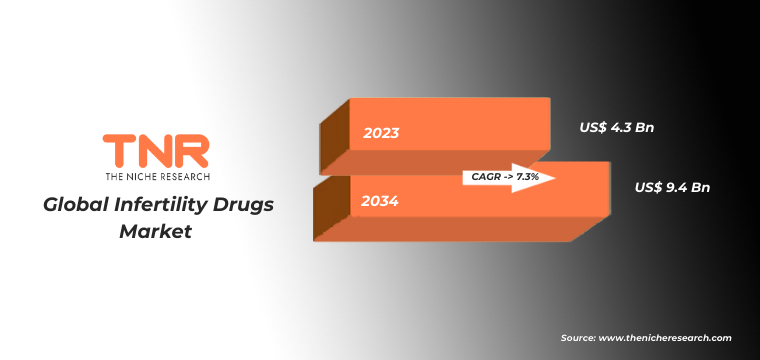
Growth Drivers in the Global Infertility Drugs Market
- Increasing Infertility Rates: The rise in infertility rates globally, due to factors such as lifestyle changes, delayed pregnancies, and environmental influences, is driving the demand for infertility drugs. This trend is propelling market growth as more individuals and couples seek medical interventions to enhance their chances of conception.
- Advancements in Reproductive Technology: Rapid advancements in reproductive technologies, including in-vitro fertilization (IVF) and intrauterine insemination (IUI), are driving the infertility drugs market. These technologies often require pharmaceutical support to improve success rates, leading to increased demand for specialized infertility medications.
Trends in the Global Infertility Drugs Market
- Technological Advancements: Advancements in drug formulations and delivery systems are revolutionizing the infertility drugs market. Innovations such as long-acting injectables and personalized medicine approaches are enhancing treatment efficacy and patient adherence, driving market growth and offering new opportunities for pharmaceutical companies.
- Rising Male Infertility Awareness: Increasing awareness and diagnosis of male infertility are significantly impacting the market. With a growing number of men seeking treatment, there is a heightened demand for targeted medications, leading to expanded research, development, and marketing efforts focused on addressing male reproductive health.
Opportunity in the Global Infertility Drugs Market
- Emerging Markets Expansion: Emerging markets, particularly in Asia-Pacific and Latin America, present substantial growth opportunities due to increasing awareness, improving healthcare infrastructure, and rising disposable incomes. Pharmaceutical companies can capitalize on these factors by expanding their presence and tailoring products to meet the unique needs of these regions.
- Integration of Telehealth Services: The integration of telehealth services into fertility treatments offers significant opportunities. Telehealth can improve access to specialist consultations, facilitate remote monitoring, and enhance patient compliance with medication regimens, thereby expanding the reach of infertility treatments and supporting market growth.
Gonadotropins has captured a substantial share of the global infertility drugs market, driven by their effectiveness in stimulating ovulation and enhancing fertility outcomes. These hormones, including follicle-stimulating hormone (FSH) and luteinizing hormone (LH), are crucial in assisted reproductive technologies such as in-vitro fertilization (IVF) and intrauterine insemination (IUI). Their ability to regulate and stimulate the ovarian cycle makes them a preferred choice among fertility specialists. Advancements in recombinant DNA technology have improved the safety and efficacy of gonadotropin products, further propelled their demand and solidified their significant market presence.
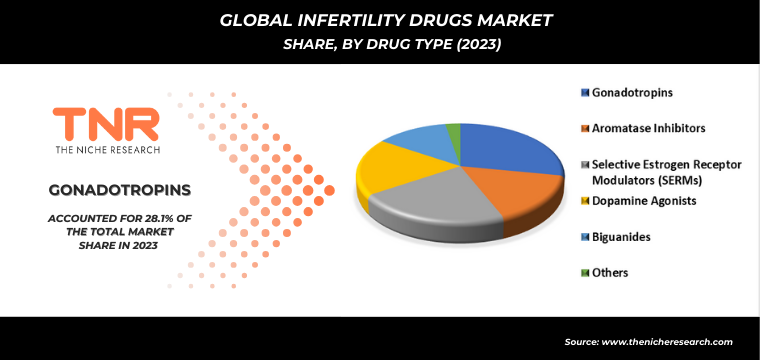
In 2023, Injectable segment by route of administration has emerged as the second-largest leading segment in the global infertility drugs market. This growth is attributed to the high efficacy and quick absorption rates of injectable medications, which are crucial for treatments requiring precise hormonal control, such as in-vitro fertilization (IVF) and ovulation induction. The convenience of self-administered injectable options and advancements in injection devices have also contributed to their popularity. Additionally, the rising prevalence of infertility and increasing awareness of advanced fertility treatments have bolstered the demand for injectable infertility drugs, reinforcing their significant market position.
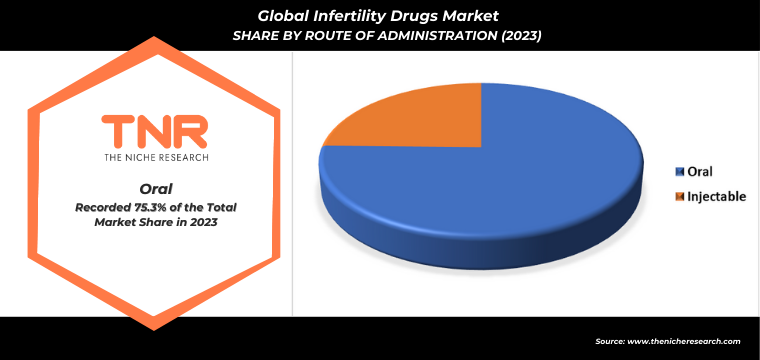
By end user, female segment dominated the global infertility drugs market and is expanding with a CAGR of 5.9% over the forecast timeline. This growth is driven by the increasing prevalence of female infertility issues, such as polycystic ovary syndrome (PCOS) and age-related fertility decline. The demand for ovulation induction drugs and hormonal therapies is rising, supported by advancements in reproductive technologies and growing awareness of fertility treatments. The expansion of fertility clinics and supportive government initiatives for women’s health further contribute to the segment’s robust growth, solidifying its leading position in the market.
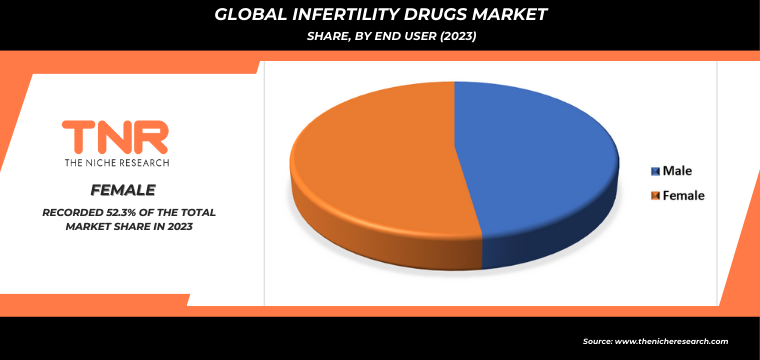
By sales channel, online channel is anticipated to grow fastest in the global infertility drugs market in 2023 with revenue share of 22.7%. This growth is driven by the increasing preference for the convenience and privacy offered by online pharmacies. The rise of e-commerce platforms and telemedicine services has made it easier for consumers to access infertility medications. Additionally, competitive pricing, home delivery options, and enhanced digital healthcare infrastructure are attracting more customers to purchase infertility drugs online. This trend reflects the broader shift towards digital health solutions, propelling the online channel’s rapid expansion in the market.
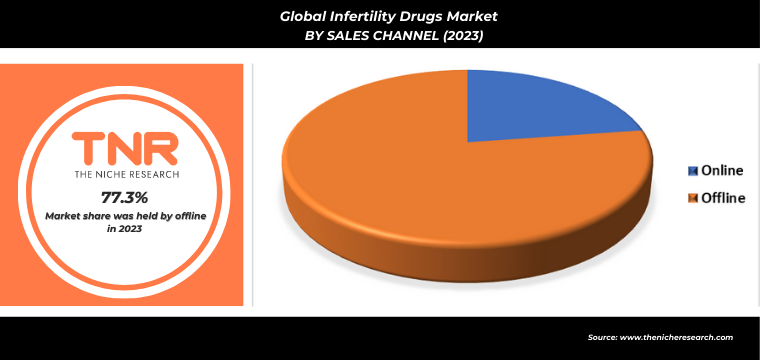
In 2023, Latin America solidified its position as the fourth leading region in the infertility drugs market due to increasing awareness and acceptance of fertility treatments. Improved healthcare infrastructure and rising disposable incomes have facilitated greater access to infertility drugs. Government initiatives and supportive policies aimed at addressing reproductive health issues have spurred market growth. The region’s expanding network of fertility clinics and growing demand for advanced reproductive technologies have further contributed to its strong market presence. This progress highlights the region’s commitment to enhancing fertility treatment accessibility and outcomes.
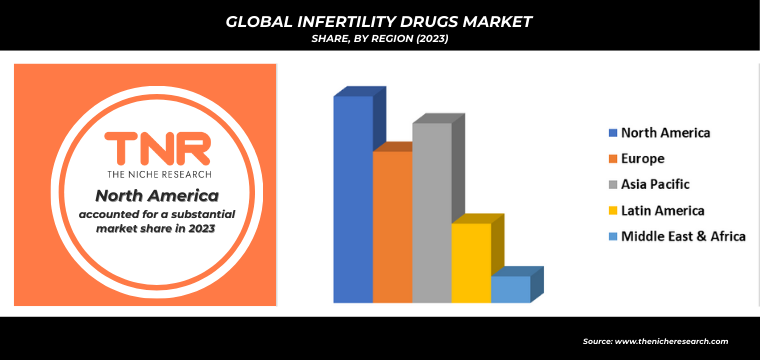
Competitive Landscape
Some of the players operating in the infertility drugs market are
- Abbott
- Bayer AG
- Ferring B.V.
- Mankind Pharma
- Merck & Co., Inc.
- Novartis AG
- Organon Group of Companies
- Pfizer Inc.
- Sanofi
- Teva Pharmaceutical Industries LTD.
- Other Industry Participants
Global Infertility Drugs Market Scope
| Report Specifications | Details |
| Market Revenue in 2023 | US$ 4.3 Bn |
| Market Size Forecast by 2034 | US$ 9.4 Bn |
| Growth Rate (CAGR) | 7.3% |
| Historic Data | 2016 – 2022 |
| Base Year for Estimation | 2023 |
| Forecast Period | 2024 – 2034 |
| Report Inclusions | Market Size & Estimates, Market Dynamics, Competitive Scenario, Trends, Growth Factors, Market Determinants, Key Investment Segmentation, Product/Service/Solutions Benchmarking |
| Segments Covered | By Drug Type, By Route of Administration, By End User, By Sales Channel, By Region |
| Regions Covered | North America, Europe, Asia Pacific, Middle East & Africa, Latin America |
| Countries Covered | U.S., Canada, Mexico, Rest of North America, France, The UK, Spain, Germany, Italy, Nordic Countries (Denmark, Finland, Iceland, Sweden, Norway), Benelux Union (Belgium, The Netherlands, Luxembourg), Rest of Europe, China, Japan, India, New Zealand, Australia, South Korea, Southeast Asia (Indonesia, Thailand, Malaysia, Singapore, Rest of Southeast Asia), Rest of Asia Pacific, Saudi Arabia, UAE, Egypt, Kuwait, South Africa, Rest of Middle East & Africa, Brazil, Argentina, Rest of Latin America |
| Key Players | Abbott, Bayer AG, Ferring B.V., Mankind Pharma, Merck & Co., Inc., Novartis AG, Organon Group of Companies, Pfizer Inc., Sanofi, Teva Pharmaceutical Industries LTD. |
| Customization Scope | Customization allows for the inclusion/modification of content pertaining to geographical regions, countries, and specific market segments. |
| Pricing & Procurement Options | Explore purchase options tailored to your specific research requirements |
| Contact Details | Consult With Our Expert
Japan (Toll-Free): +81 663-386-8111 South Korea (Toll-Free): +82-808- 703-126 Saudi Arabia (Toll-Free): +966 800-850-1643 United Kingdom: +44 753-710-5080 United States: +1 302-232-5106 E-mail: askanexpert@thenicheresearch.com
|
Global Infertility Drugs Market
By Drug Type
- Gonadotropins
- Aromatase Inhibitors
- Selective Estrogen Receptor Modulators (SERMs)
- Dopamine Agonists
- Biguanides
- Others
By Route of Administration
- Oral
- Injectable
By End User
- Male
- Female
By Sales Channel
- Online
- Offline
- Hospital Pharmacy
- Specialty and Retail Pharmacy
By Region
- North America (U.S., Canada, Mexico, Rest of North America)
- Europe (France, The UK, Spain, Germany, Italy, Nordic Countries (Denmark, Finland, Iceland, Sweden, Norway), Benelux Union (Belgium, The Netherlands, Luxembourg), Rest of Europe)
- Asia Pacific (China, Japan, India, New Zealand, Australia, South Korea, Southeast Asia (Indonesia, Thailand, Malaysia, Singapore, Rest of Southeast Asia), Rest of Asia Pacific)
- Middle East & Africa (Saudi Arabia, UAE, Egypt, Kuwait, South Africa, Rest of Middle East & Africa)
- Latin America (Brazil, Argentina, Rest of Latin America)
Report Layout:
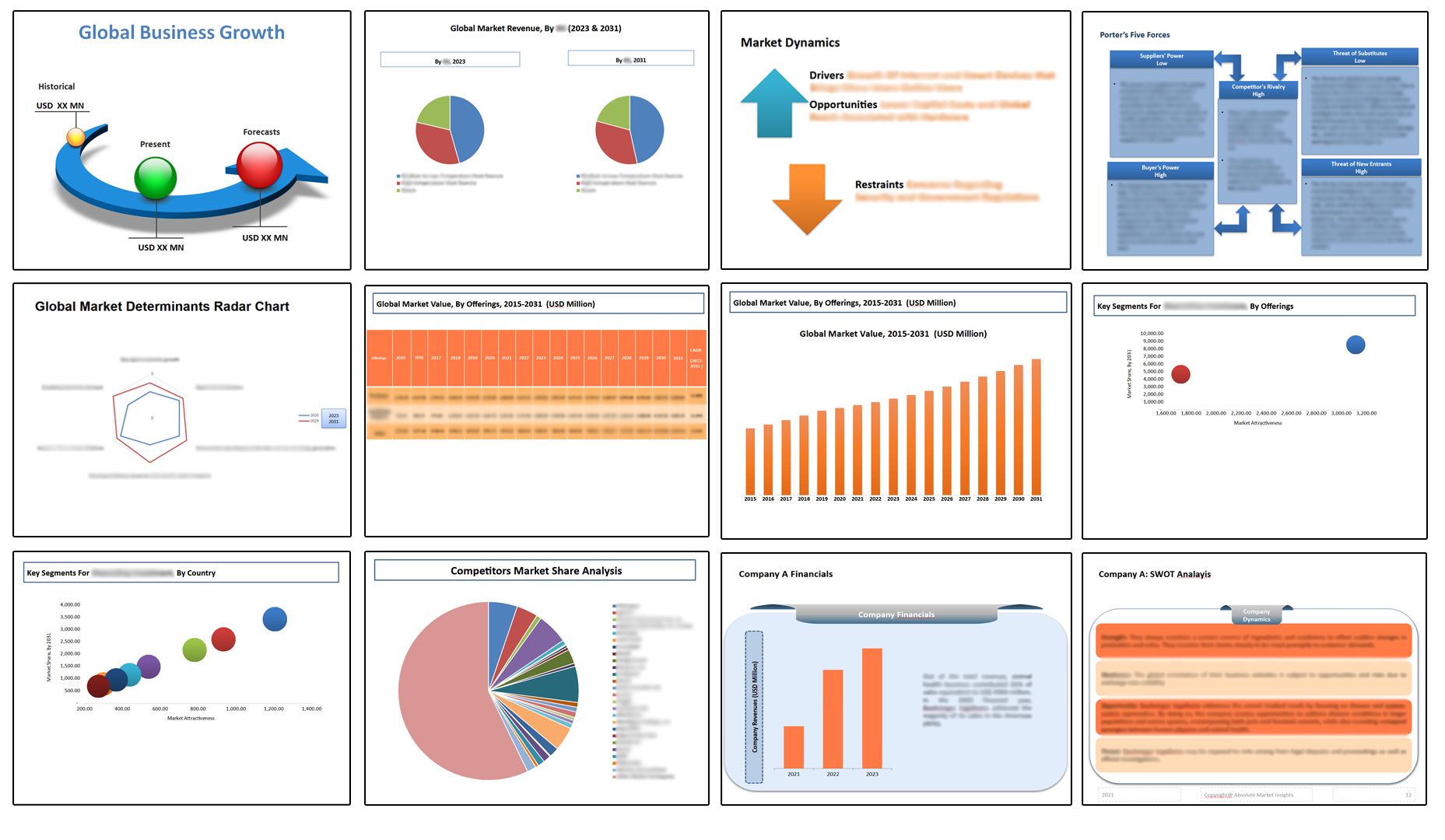
Table of Contents
Note: This ToC is tentative and can be changed according to the research study conducted during the course of report completion.
**Exclusive for Multi-User and Enterprise User.
Global Infertility Drugs Market
By Drug Type
- Gonadotropins
- Aromatase Inhibitors
- Selective Estrogen Receptor Modulators (SERMs)
- Dopamine Agonists
- Biguanides
- Others
By Route of Administration
- Oral
- Injectable
By End User
- Male
- Female
By Sales Channel
- Online
- Offline
- Hospital Pharmacy
- Specialty and Retail Pharmacy
By Region
- North America (U.S., Canada, Mexico, Rest of North America)
- Europe (France, The UK, Spain, Germany, Italy, Nordic Countries (Denmark, Finland, Iceland, Sweden, Norway), Benelux Union (Belgium, The Netherlands, Luxembourg), Rest of Europe)
- Asia Pacific (China, Japan, India, New Zealand, Australia, South Korea, Southeast Asia (Indonesia, Thailand, Malaysia, Singapore, Rest of Southeast Asia), Rest of Asia Pacific)
- Middle East & Africa (Saudi Arabia, UAE, Egypt, Kuwait, South Africa, Rest of Middle East & Africa)
- Latin America (Brazil, Argentina, Rest of Latin America)
The Niche Research approach encompasses both primary and secondary research methods to provide comprehensive insights. While primary research is the cornerstone of our studies, we also incorporate secondary research sources such as company annual reports, premium industry databases, press releases, industry journals, and white papers.
Within our primary research, we actively engage with various industry stakeholders, conducting paid interviews and surveys. Our meticulous analysis extends to every market participant in major countries, allowing us to thoroughly examine their portfolios, calculate market shares, and segment revenues.
Our data collection primarily focuses on individual countries within our research scope, enabling us to estimate regional market sizes. Typically, we employ a bottom-up approach, meticulously tracking trends in different countries. We analyze growth drivers, constraints, technological innovations, and opportunities for each country, ultimately arriving at regional figures.Our process begins by examining the growth prospects of each country. Building upon these insights, we project growth and trends for the entire region. Finally, we utilize our proprietary model to refine estimations and forecasts.
Our data validation standards are integral to ensuring the reliability and accuracy of our research findings. Here’s a breakdown of our data validation processes and the stakeholders we engage with during our primary research:
- Supply Side Analysis: We initiate a supply side analysis by directly contacting market participants, through telephonic interviews and questionnaires containing both open-ended and close-ended questions. We gather information on their portfolios, segment revenues, developments, and growth strategies.
- Demand Side Analysis: To gain insights into adoption trends and consumer preferences, we reach out to target customers and users (non-vendors). This information forms a vital part of the qualitative analysis section of our reports, covering market dynamics, adoption trends, consumer behavior, spending patterns, and other related aspects.
- Consultant Insights: We tap into the expertise of our partner consultants from around the world to obtain their unique viewpoints and perspectives. Their insights contribute to a well-rounded understanding of the markets under investigation.
- In-House Validation: To ensure data accuracy and reliability, we conduct cross-validation of data points and information through our in-house team of consultants and utilize advanced data modeling tools for thorough verification.
The forecasts we provide are based on a comprehensive assessment of various factors, including:
- Market Trends and Past Performance (Last Five Years): We accurately analyze market trends and performance data from preceding five years to identify historical patterns and understand the market’s evolution.
- Historical Performance and Growth of Market Participants: We assess the historical performance and growth trajectories of key market participants. This analysis provides insights into the competitive landscape and individual company strategies.
- Market Determinants Impact Analysis (Next Eight Years): We conduct a rigorous analysis of the factors that are projected to influence the market over the next eight years. This includes assessing both internal and external determinants that can shape market dynamics.
- Drivers and Challenges for the Forecast Period:Identify the factors expected to drive market growth during the forecast period, as well as the challenges that the industry may face. This analysis aids in deriving an accurate growth rate projection.
- New Acquisitions, Collaborations, or Partnerships: We keep a close watch on any new acquisitions, collaborations, or partnerships within the industry. These developments can have a significant impact on market dynamics and competitiveness.
- Macro and Micro Factors Analysis:A thorough examination of both macro-level factors (e.g., economic trends, regulatory changes) and micro-level factors (e.g., technological advancements, consumer preferences) that may influence the market during the forecast period.
- End-User Sentiment Analysis: To understand the market from the end-user perspective, we conduct sentiment analysis. This involves assessing the sentiment, preferences, and feedback of the end-users, which can provide valuable insights into market trends.
- Perspective of Primary Participants: Insights gathered directly from primary research participants play a crucial role in shaping our forecasts. Their perspectives and experiences provide valuable qualitative data.
- Year-on-Year Growth Trend: We utilize a year-on-year growth trend based on historical market growth and expected future trends. This helps in formulating our growth projections, aligning them with the market’s historical performance.
Research process adopted by TNR involves multiple stages, including data collection, validation, quality checks, and presentation. It’s crucial that the data and information we provide add value to your existing market understanding and expertise. We have also established partnerships with business consulting, research, and survey organizations across regions and globally to collaborate on regional analysis and data validation, ensuring the highest level of accuracy and reliability in our reports.









